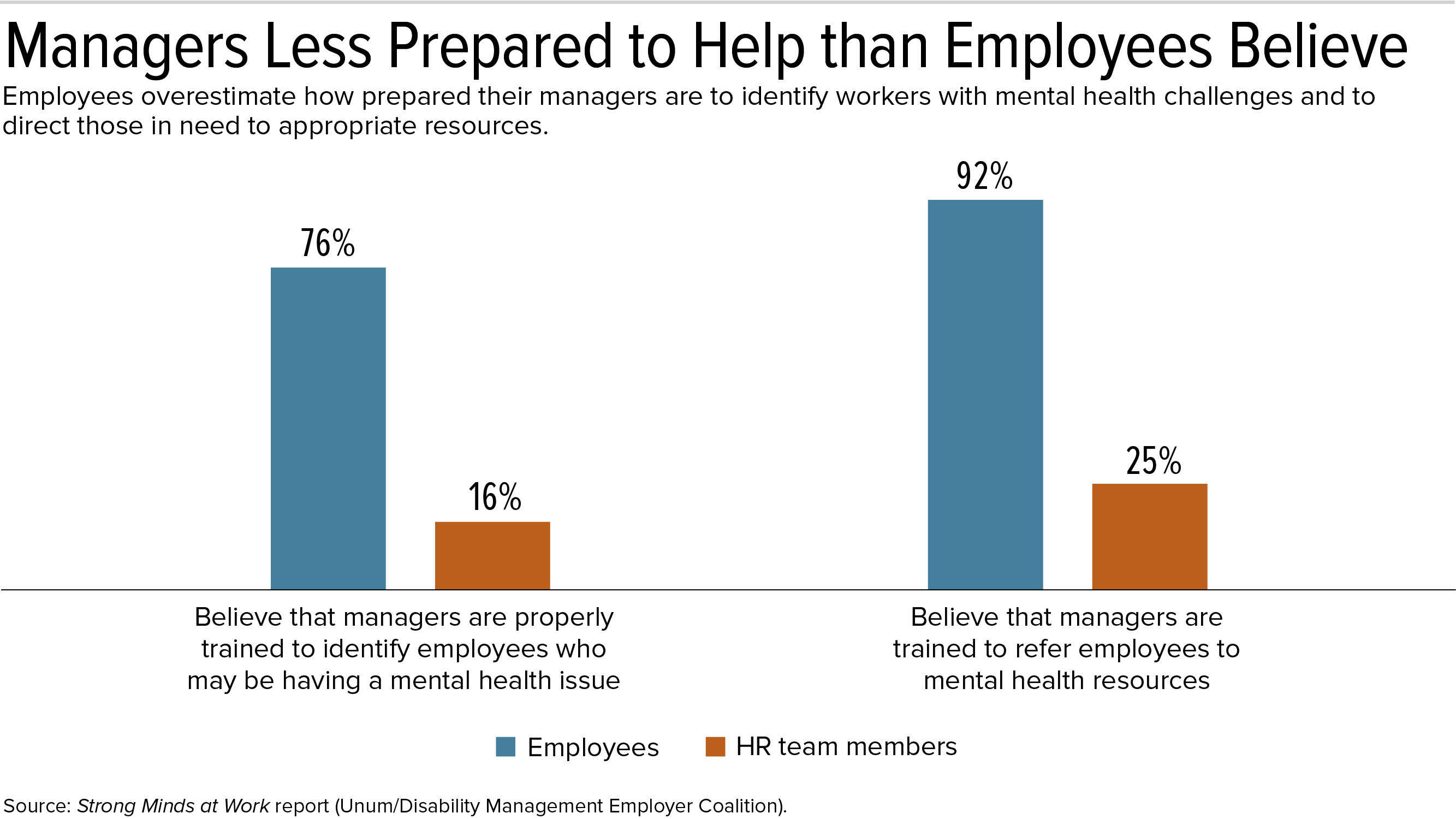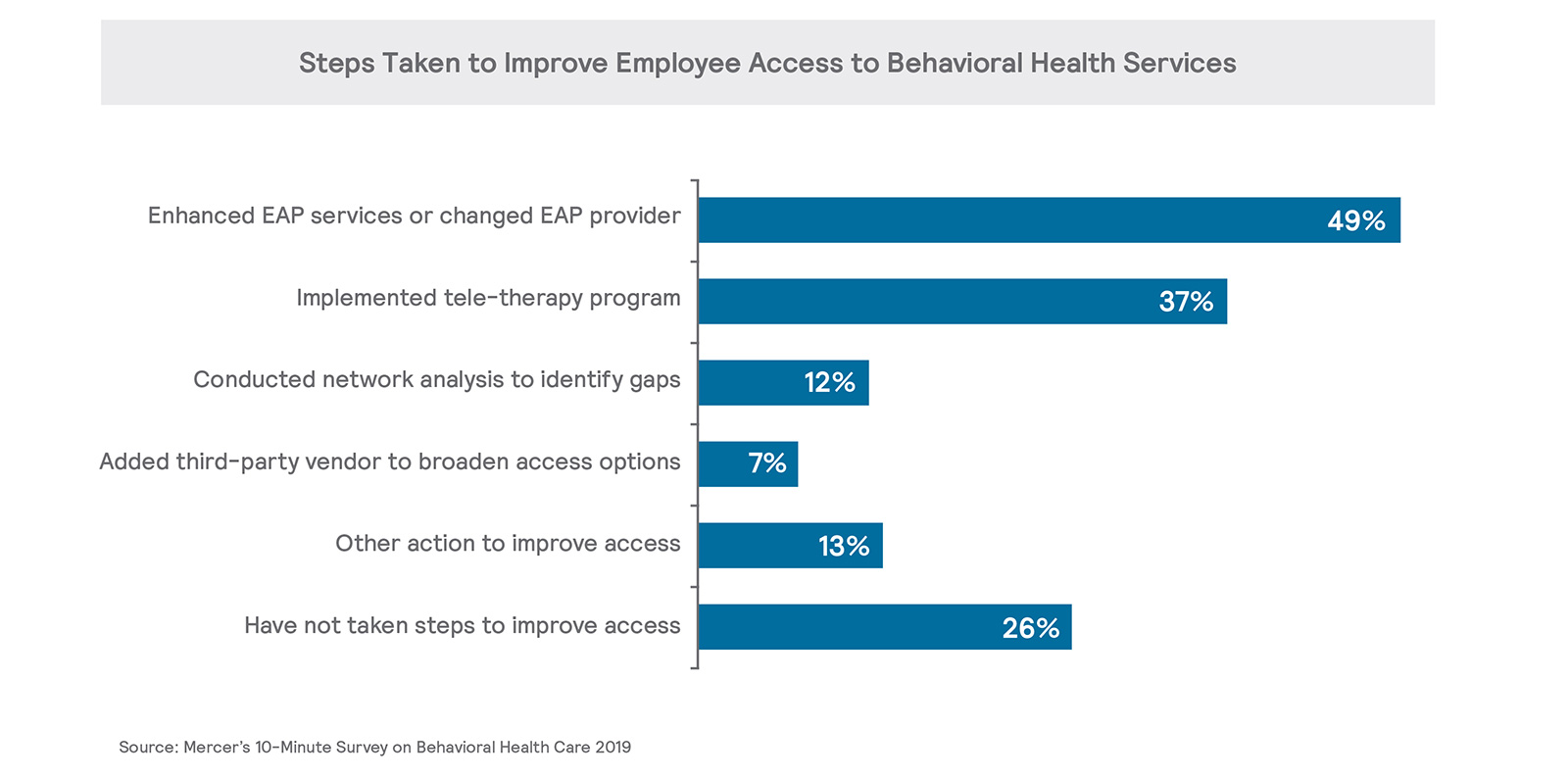Employers Fight the Stigma Around Mental Health Care
Be prepared to direct employees to benefits and resources

updated May 29, 2019
Just 25 percent of managers in the U.S. have been trained in referring employees to mental health resources, according to findings released in May during Mental Health Awareness Month.
Managers' lack of preparation in dealing with employees who have mental health issues was highlighted in Strong Minds at Work, a new report from Unum, a provider of financial protection benefits. Earlier this year, a poll by Unum and the nonprofit Disability Management Employer Coalition (DMEC) drew responses from 1,850 working adults and 268 HR professionals.
"Creating a workplace culture that promotes mental health resources and encourages employees to take advantage of them helps to destigmatize mental health issues and leads to a happier, more productive workforce," said Michelle Jackson, assistant vice president of market development at Unum.
Roughly 45 million U.S. adults experience mental illness each year, according to the National Institute of Mental Health. Depression alone costs the U.S. economy an estimated $210 billion per year, with more than 60 percent of that cost going to treat medical conditions that often accompany mental health issues, such as diabetes and heart disease, according to a study published in the Journal of Clinical Psychiatry.
The Unum/DMEC survey results showed that:
- 63 percent of those with a mental health issue such as anxiety or depression took time off because of it. Of these employees, over half (54 percent) used paid time off such as sick days and vacation, while over a quarter (27 percent) used unpaid leave.
- 61 percent of respondents feel there's a social stigma in the workplace toward colleagues with mental health issues.
- 55 percent said their employer did not have—or were unsure if their employer had—a program, initiative or policy to address mental health.
In an indication that stigma remains widespread, 70 percent of employees who missed work due to mental health issues did not inform their manager that this was the reason.
Employers can support employees with mental health issues, the report advises, by training managers to recognize signs that employees are having difficulty coping with normal workplace pressures. Managers or the HR staff can direct employees to mental health resources that may include medical care through the health plan, an employee assistance program (EAP) offering mental health counseling, and financial and legal counseling.
Perception Gap
Tellingly, 76 percent of employees surveyed said they were confident their managers were properly trained on how to identify employees who may have a mental health issue, while just 16 percent of the HR professionals felt the same, the Unum/DMEC survey found.
Meanwhile, 92 percent of employees thought managers at their organizations were trained on how to refer employees to mental health resources, while just 25 percent of HR professionals said their managers receive that training.
(Click on graphic to view in a separate window.)
Expanding Mental Health Benefits
In a new survey of 523 employers by HR consultancy Mercer, almost two-thirds of respondents said that adequate access to outpatient behavioral health care is lacking in some or all of their locations. But many employers are taking action to increase employee access to behavioral health services, the survey also found.
Given that most respondents have an EAP in place, many have chosen to start there. About half (48 percent) have enhanced the services offered by the EAP within the last two years, or changed EAP vendors to provide a more robust offering, Mercer found. Expanded EAP offerings include onsite counseling services and online programs using cognitive behavioral theory to address anxiety, depression, sleep and pain.
Just over a third (37 percent) of respondents have recently implemented a tele-therapy program through the medical offering's telemedicine vendor. Tele-therapy expands access options for behavioral health and psychiatric services, and can offer less-stigmatized access to these services, Mercer said.
CEOs Get on Board
More than 40 CEOs from large companies partnered with the American Heart Association (AHA) earlier this year to promote mental health-friendly workplaces.
The AHA CEO Roundtable report, Mental Health: A Workforce Crisis, analyzed findings from several studies on employee mental health issues.
"As CEOs, we must lead by example and engage other business leaders in redefining workplace inclusiveness and powering a mental health movement," wrote Alex Gorsky, chairman and CEO of Johnson & Johnson; Brian Moynihan, chairman and CEO of Bank of America; and the AHA's CEO, Nancy Brown, on behalf of the roundtable. "We cannot afford to let social stigma and discrimination hinder an individual's ability to achieve optimum health and employment," they added.
The group recommended actions in these areas:
- Leadership. Visibly position leaders to champion a mental health-friendly workplace.
- Engagement. Involve employees in all aspects of mental health-related workplace decision-making.
- Benefits. Offer a comprehensive package of employee-centered medical benefits and programs. Develop and implement a mental health plan that makes accessing these resources easy for employees.
- Communications. Communicate clearly and often to employees about the organization's mental health policies and benefits.
- Community partnerships. Use community partnerships to promote the objectives of the mental health plan, such as community-based organizations that provide mental health services.
EAPs
The effectiveness of EAPs can vary significantly based on their funding, quality and use, the roundtable found.
A recent trend in decreasing costs paid to EAPs may help employers spend less, the report noted, "but the effectiveness of programs may be reduced because providers may not able to offer the highest-quality services at such low prices."
The rate of EAP use also remains stubbornly low, at about 6.5 percent. "If employees are not using the available EAP services, then it does not matter how effective they are," the report pointed out. "This emphasizes a need for employers to better market and promote their available EAP programs to increase usage rates."
Shira Wilensky, a national practice leader for health and well-being at OneDigital, an employee benefits and health insurance broker, commented that "employees are afraid to put themselves in a category of needing assistance. They feel they are admitting weakness, which puts their job—therefore their livelihood—in jeopardy."
There are also problems accessing EAPs, she noted, and "even employees who do seek help from the employer's EAP often cannot get an appointment right away." They may also find that only a limited number of counseling sessions are provided.
[SHRM members-only toolkit: Managing Employee Assistance Programs]
Digital Tools
"The last decade has seen an explosion of workplace digital tools targeting mental health," the roundtable report noted, and these "may be appealing to employers because they offer the prospect of reaching more employees with potentially greater economic efficiency."
Digital mindfulness and stress-management tools, for example, can have a moderate to strong effect on reducing stress and moderate anxiety.
The positive effects of online tools, however, did not extend to more-serious mental health conditions, such as depression or severe anxiety, for which counseling and prescribed medication could be more-appropriate treatments.
"There are a variety of digital tools on the market to promote mental health, from mindfulness and meditation apps that guide you through breathing exercises and medications on your smartphone, to clinical assessment tools," Wilensky said. Access to these tools lets employers "make the information accessible in a way that feels more private and can be less intimidating for the segment of the population that is comfortable using technology," she noted.
Related SHRM Articles:
Underused EAPs Are a Missed Opportunity to Help Workers, SHRM Online, August 2019
Young Workers Report an Alarming Increase in Depression, SHRM Online, May 2019
Different Demographic Groups Experience Mental Health Challenges in Unique Ways, SHRM Online, May 2019
How Can Employers Help End the Stigma Surrounding Mental Health?, SHRM Blog, June 2018
Overcoming Stigma Around Mental Health Services, SHRM Online, March 2016
How to Accommodate Employees with Mental Illness, HR Magazine, September 2014
An organization run by AI is not a futuristic concept. Such technology is already a part of many workplaces and will continue to shape the labor market and HR. Here's how employers and employees can successfully manage generative AI and other AI-powered systems.





